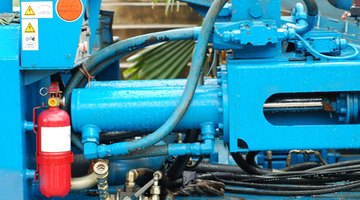How to Clean a Hydraulic System
Cleaning, or flushing, a hydraulic system entails removing all of the sludge, debris and other contaminants from the system.

Although the basic method of flushing hydraulic systems remains generally the same, the actual amount of time, energy and resources require to fully flush a system depend on the system's size and type. For example, a car's hydraulic braking system will take less time and fewer resources to clean than a large hydraulic plumbing system.
Things You Will Need
- Hydraulic filter cart
- Oil
- Pneumatic projectile launcher
- Brushes
- Cleaning solvent
Tip
Be proactive about cleaning your hydraulic system to avoid requiring such a drastic cleaning procedure.
-
Identify the layout of your hydraulic system and formulate a plan for cleaning it. Due to the wide array of hydraulic systems and your own specific needs, you may or may not need all of the listed materials. If you can find the instruction manual or guidebook for your particular hydraulic system, cleaning instructions will usually be included.
-
Drain the oil from the hydraulic system and change the filter(s). After all of the oil has been drained, refill the system with the minimum amount of fluid. Activate the machine and circulate the fluid through mild, controlled use of the system. After the fluid has been cycled at least 5 times, drain the oil again and repeat the process. Afterward, test the hydraulic system with an oil analysis to determine the effectiveness of the cleaning process.
-
Attach the open end of the pneumatic projectile launcher onto one of the opening nozzles of your hydraulic system, though only if it's a large enough system for the launcher to be needed. Activate the launcher and shoot it at least six times to effectively remove contaminates from the hose.
-
Disassemble as much of the hydraulic system as possible. At the very least the reservoir is usually detachable for cleaning. Use your choice of cleaning solvent and a heavy-duty grill brush to remove all dregs of oil, sludge and contaminants from the parts.
-
Plug up the hydraulic filter cart, if your system is large enough to require this, and force low-viscosity fluid through at a velocity that creates inertial forces greater than 2000Re (Reynold's Number) but less than 4000Re. Please see the manufacturer's instructions for more details on this process.
-
Monitor the success of your flushing through visual inspection and by taking sample fluid. Continue to run fluids through the hydraulic system for 15 minutes after desired cleanliness level is reached.
-
Drain the system and use the filter cart to blow hot air through for drying.
-
Refill the hydraulic system with the specified amount of fluid and run the fluid through the system at least seven times before putting the system back to use. The larger your system, the more you will need to circulate the new fluid to ensure the system is running properly post-flushing.
The Drip Cap
- Cleaning, or flushing, a hydraulic system entails removing all of the sludge, debris and other contaminants from the system.
- If you can find the instruction manual or guidebook for your particular hydraulic system, cleaning instructions will usually be included.
- Afterward, test the hydraulic system with an oil analysis to determine the effectiveness of the cleaning process.
- Drain the system and use the filter cart to blow hot air through for drying.
- The larger your system, the more you will need to circulate the new fluid to ensure the system is running properly post-flushing.
References
Writer Bio
Brian Massey began his professional writing career in 2008. He has published articles relating to technology, health and fitness, and online marketing on various websites. Massey is pursuing a Bachelor of Science in video-game programming at DeVry University.
Photo Credits
- hydraulic machine image by Heng kong Chen from Fotolia.com
- hydraulic machine image by Heng kong Chen from Fotolia.com
More Articles



